8 Great Plants for a Late Season Show
October 5, 2010 by admin
Filed under Autumn, Autumn Bloomers, Seasons in the Garden
It’s an accepted truth in the retail nursery industry that most customers only buy plants when they’re in full bloom. It’s not hard to guess, then, why many gardens are lacking in late-season plants. By August, gardeners are a little tuckered out and less likely to visit nurseries, so they never get to know all the wonderful plants that are at their best from September onward.
There are so many impressive late-season garden performers, in fact, that I had trouble whittling the list down to just eight. In the end, it was a bit of a coin toss, and I opted to focus more on plants that are less common or have exceptionally long “peak” periods. The runners-up include the old reliable and ubiquitous black-eyed Susan (Rudbeckia), the late flowering bugbanes such as Cimicifuga ‘Hillside Black Beauty’ (not the native C. racemosa, which starts and finishes flowering earlier), and the native asters (two of which I profiled here).
All of these plants require plenty of sun and well-drained soil, with the exception of turtlehead, which can tolerate light shade and a moist spot in the garden.
As a general design rule of thumb, I like to group plants that peak at the same time near one another in the garden rather than space them out too much. A combination I like a lot starts with a tall pink New England or New York aster such as ‘Alma Potschke’ at the rear. In front of that put a few specimens of burgundy-leaved snakeroot (Eupatorium rugosum ‘Chocolate’—see below). Finally, add Northern sea oats (Chasmanthium latifolium—again, see below) in the foreground. The aster will get “bare legs” as the season progresses, as pretty much all tall asters do, but they’ll be hidden by the bushy foliage of the snakeroot. A pink aster, meanwhile, will bring out the deep purple tones of the snakeroot’s foliage. At the front, the heavy, showy seedheads of the ornamental oats will arch gracefully, dance in the slightest breeze, and slowly turn from green to russet as autumn progresses. With a little thought, I’m sure you’ll find many wonderful combinations using these 8 great late-season plants.
 Japanese anemone
Japanese anemone
Anemone x hybrida ‘Robustissima’
All of the Japanese anemones are good performers, but I recommend ‘Robustissima’ for the North because of its exceptional hardiness. This plant is late to emerge in spring but quickly produces a dense 2-3’ tall clump of grape leaf-shaped foliage. In August, delicate, naked stems spring up another foot, topped by poetically fragile, shell pink flowers. Although it can be aggressive in some gardens, it’s generally not a problem plant. Spraying with deer repellant is essential since it’s a favorite of the hooved crowd.
 Northern sea oats
Northern sea oats
Chasmanthium latifolium
It’s a mystery to me why this medium-sized, self-supporting, very showy and native grass isn’t more common in our gardens! It looks great next to just about any companion, mixes well with small shrubs such as spireas, and its seed heads are long lasting when harvested and dried for arrangements. Grows 2.5-3’ high and 2’ wide.
 Turtlehead
Turtlehead
Chelone
The two species of turtlehead native to North America and occasionally used in gardens bloom white or pale pink in the wild, but the much more brightly colored cultivar ‘Hot Lips’ is what you’re more likely to find for sale at nurseries. Turtlehead is notable for its extremely long flowering period and robust, healthy foliage. If grown in shade, it can be lax, but in sun I’ve found it to be entirely self-supporting and a nearly no-care plant for the front of the border.
 Dahlia
Dahlia
Dahlia
Dahlias, of course, aren’t cold hardy in New England, but of all the common tender tubers and bulbs, it’s the most rewarding. It’s often thought of as just a fall-blooming plant, but that doesn’t have to be so. I put dahlias in the ground around the second week of May. They generally break ground in late May, just when the threat of frost is passing. If you plant them this way, you’ll have flowers starting in July, and they’ll keep going until hard frost, making dahlias one of the longest blooming plants available. I avoid dahlias with enormous flowers because their stems are prone to breakage from the excessive weight they have to bear. Provide tall dahlias with support, and to successfully overwinter them, pack them in ever-so-slightly damp light soil or another medium (nearly anything, from sphagnum moss to wood shavings, will do) and store them at 40 degrees F in a container that is not completely airtight. I’ve overwintered them in everything from damp basements to dry, heated sheds; they seem less sensitive to humidity than temperature—they do not want to get warm! With a little luck, dahlias can last for many, many years.
 Chrysanthemum or Mum
Chrysanthemum or Mum
Dendranthema
A mum by any other name is still a mum…but these days, it’s more likely to be called Dendranthema. Unless you go out of your way to find unusual varieties, the ones you’re most likely to see are apricot-pink ‘Sheffield’ or its lookalike, ‘Cambodian Queen’. Both are bone hardy and medium sized, making them suitable for most New England gardens. Mums, like asters, get “bare legs” and should be planted behind something lower growing and bushy to look their best. They’ll be dense and less likely to flop if you pinch them once or twice by removing a third of their growth before mid July.
 Hardy ageratum
Hardy ageratum
Eupatorium coelestinum, syn. Conoclinium coelestinum
If you’re a lover of blue flowers, you’ll want this. Its stems won’t elongate until well after other plants have put on lots of growth, but be patient—it will become bushy once it gets going, growing 2’ tall and indefinitely wide via a dense mat of spreading roots. Regular division is essential! Its exceptional flower color echoes that of Lobelia siphilitica and Caryopteris x clandonensis.
 Snakeroot
Snakeroot
Eupatorium rugosum, syn. Ageratina altissima
This New England native plant is so dirt common you may have dozens of them growing on your property without even knowing it, but you’ll be amazed at what a bushy, showy plant it becomes when you move it away from the woodland edges where it naturally finds its niche and give it the space and sunlight of a perennial border. Its sprays of small white flowers attract a wide variety of nectar feeders. Although the cultivar ‘Chocolate’ (referring to its burgundy leaves) is more commonly offered for sale in nurseries, the plain green-leaved roadside species is equally beautiful.
 Fountain grass
Fountain grass
Pennisetum alopecuroides
Here’s a second moderately sized, self-supporting grass with showy seedheads and absolutely minimal maintenance needs. It’s common in commercial plantings, but home gardeners often ignore it in favor of larger, harder to manage grasses. Fountain grass is the perfect companion for any Sedum spectabile, such as ‘Autumn Joy’. Its mophead shape makes it a natural choice for the “first tier” of the perennial border, where its delicate blades can drape gracefully over the edge between border and path.
Winter Is Wonderful
February 9, 2010 by admin
Filed under Seasons in the Garden, Winter
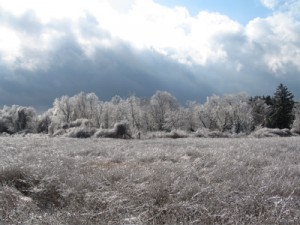
Every time I give a winter lecture (like the one I presented at the Berkshire Botanical Garden in Stockbridge, MA the other day), I can always count on several people saying, “You must be champing at the bit for spring to arrive!” Well, actually…no, I’m not.
It’s not because winter is my “off season” when I get a chance to rest and recharge. The fact is, every season is incredibly busy for me, including the coldest months. And it’s also not because I’m an avid (if only marginally talented) skier, although I admit to eying slopeside cabins in the Canadian Rockies as ideal retirement property.
I’m a four-season kind of person, which is why I live in a part of the world that’s supposed to get four distinct seasons. I have an interest in all kinds of flora and fauna, but I’m especially fascinated by the plants and animals that live where conditions are in a constant state of change. Winter is an integral part of that change, and I’m always a bit surprised by the dislike other people express for this beautiful, important season, and especially for the snow that should come along with it.
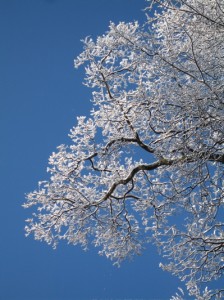
An early December storm left these branches traced in snow.
Gardeners in the Northeast should love winter and snow, for a lot of reasons. First, if we didn’t have winter, New England wouldn’t be New England. There’d be no sugar maples, no white birches, and no apple crop in autumn. We wouldn’t even have the stone walls that famously crisscross our landscape, because it’s the freeze/thaw cycle that brings rocks to the surface, where farmers have to remove them from fields.
As for snow, its importance just can’t be overstated. The day after Thanksgiving, I say, “let it snow and keep on coming.” I don’t want to see the ground until April, and I can guarantee you that the plants are with me on that one. A nice thick layer of protective snow is just the insulation they all need.
Longtime gardeners eventually begin to notice patterns—events that occur regularly, if not always cyclically. One of the recurring patterns in the Northeast is the winter where nearly every individual of a particular type of plant dies. The discovery is made in spring when gardeners begin to chat with one another about what did and did not “come back.”
This often happens with plants that are at the northern edge of their growing range in the North to begin with, such as butterfly bush (Buddleia). In Zone 5, it’s considered perfectly normal for butterfly bush to die back to the ground, even though it’s a woody plant. When a plant is living on that edge, it doesn’t take much in the way of stress to push it over the cliff.
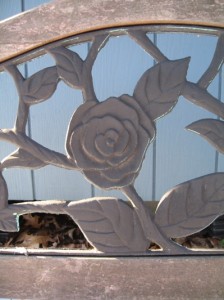
I have a "rosy" view of winter...
Interestingly, though, it also sometimes happens with plants that are hardier overall, such as sweet autumn clematis (Clematis maximowicziana). It isn’t always obvious what happened to cause these widespread losses, but I think it’s safe to say that when the majority of all the sweet autumn clematis plants in a region die one winter, it’s probably because of some large-scale environmental factor.
All you can do is take an educated guess at the reason for these events. Things plants generally don’t like include temperatures below freezing and blasts of Arctic wind without snow cover, and rapid changes in temperature, particularly when they swing around the freezing point (15°F one day, 50°F the next). People might like mid-winter thaws, but warm interludes in what should be a cold season generally just confuse and weaken plants. A lack of snow just makes them more susceptible to damage when temperatures inevitably drop again. Gardeners shouldn’t take it too personally when these deaths occur; they don’t imply failure of the gardener.
So, I’d like to respectfully suggest that gardeners should have a higher opinion of winter and snow! Yes, snow also has its down side—for one thing, rodent damage to plants can be worse in very snowy winters—but on the whole, it’s immensely beneficial, and it’s free. If that doesn’t warm the cockles of a New Englander’s heart, I don’t know what will!

A winter reading gem: Bernd Heinrich's Winter World
Recently, I discovered a wonderful book that celebrates winter and snow in an engaging way: Winter World: The Ingenuity of Animal Survival by Bernd Heinrich. Although this is a little off the topic of gardening, it’s not at all off the topic of why a lot of people garden: a love of the outdoors. In the wrong hands, a topic like the mechanics of winter survival could be dry and uninteresting. But in Winter World, one man’s love of land and the plants and animals that occupy it makes the subject come alive. Heinrich traces the web of connections between animals and plants, and every gardener should be interested in that.
It’s all too easy for gardeners to fall prey to the fallacy that gardening is about shaping the natural world to our liking. If you allow yourself to think that, nature has a way of eventually showing you that you’re not really in control. I prefer to see gardening as a tool for learning about the processes of the natural world and especially how plants and animals interact. The puzzle of these interactions is one of the greatest stories that could be told, and winter is a big piece of it.
Read Winter World and you’ll gain a greater appreciation for how contradictory individual plant and animal life is, simultaneously tenuous and tenacious. It may help impatient gardeners live a little more in the moment of winter instead of wishing for it to end, and it’s definitely something worth pondering as Earth’s quietest season ticks by.
August Asters
August 21, 2009 by admin
Filed under Perennials, Summer, Summer Bloomers
We’ve all heard the expression “familiarity breeds contempt.” Well, it’s as true in the garden world as in the great wide world. Some of the best garden plants grow wild all around us and never get the recognition they deserve because they’re, well, common.
Native asters are a case in point. The Northeast is aster country, home to handfuls of species, and they’re so widespread that even a short walk down a country lane in August will probably turn up half a dozen kinds.
Never mind that the taxonomists have been at it again and the genus Aster was recently carved up and parceled out into several new genera including Eurybia and Symphyotrichum. “August Symphyotrichums?” I think not. I say if it walks like a duck and talks like a duck, it’s an aster…or, well, you know what I mean.
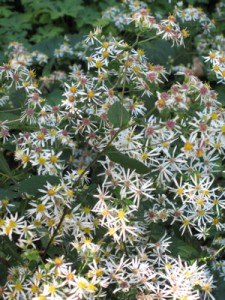
White wood aster is as close to a no-care plant as a plant can get, and native to boot
I have a soft spot for asters, especially the delicate roadside kinds, because they start to bloom at just the time of year when it doesn’t seem like anything should be able to look good. “Sticky heat” is a typical mid August weather forecast in this part of the world, and I know those conditions don’t exactly bring out the best in me. In fact, the word that usually springs to mind when I think of August is “awful!” But when I’m feeling like a wrung-out dishrag, asters are just starting to look cool, fresh and flowery.
Two of the best native species have begun to make headway in the gardening world in the last couple of years and are no longer strictly speaking “specialty plants.” Major plant growers are now propagating them, and you should be able to find them or order them at good nurseries.
My favorite native roadside aster is white wood aster (Aster divaricatus, recently rechristened Eurybia divaricata—yuck!). I frequently say that there’s no such thing as a no-care plant, but if forced at gunpoint to name the closest thing, this would be it.
White wood aster is a well-behaved plant, growing only about 24″ tall and completely capable of supporting itself. Its stems are black and its leaves broad, medium green and attractive. It’s been in the vegetative background for several months now, just growing slowly and steadily, but in the past week its flowers have begun to pop, making it more noticeable.
White wood aster is like a black sweater in your wardrobe-it goes with everything. It’s a little too tall to plant at the very forefront of most gardens, but set back a foot of two in your border it will shine no matter what its companions. White wood aster is sometimes offered under the cultivar name ‘Eastern Star’. To be honest, I can’t see any difference between the species and the supposedly improved cultivar, so don’t fret the presence or absence of a cultivar name.
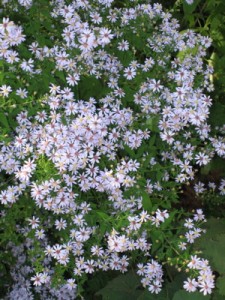
Blue wood aster in all its flowery August glory
The other aster I await with anticipation every year is blue wood aster (Aster cordifolius, recently renamed Symphyotrichum cordifolium—double yuck!). It can grow to four or even five feet in height, and if not staked it will flop over. If grown with enough other tall things around it, it can simply drape itself over them prettily. Possible garden cohorts might include Japanese anemone (Anemone x hybrida), yellow waxbells (Kirengeshoma), toad lily (Tricyrtis), turtlehead (Chelone), snakeroot (Eupatorium rugosum) and northern sea oats (Chasmanthium latifolium).
If you don’t stake it, I’d recommend pinching it early in the season when it reaches a height of two feet or so. You don’t have to get fussy and give it a $100 haircut. One good whack with a pair of hedge clippers, removing up to half the growth, will do the job. “Pinching” it in this way will also delay flowering somewhat, as pinching usually does. You can treat white wood aster the same way if you want it to be shorter or bushier for any reason.
As its name suggests, the flowers of blue wood aster are blue, although personally I’d call their hue more of an icy violet. It’s an interesting color that changes depending on the quality and angle of the light, making the plant something to go out of your way to see at different times of day and in every kind of weather.
Blue wood aster is most frequently offered in a form called ‘Avondale’. It does seem to me that ‘Avondale’ is more floriferous than the straight species, but you can’t go wrong with either one.
White wood aster and blue wood aster share a pair of wonderful traits. First, they aren’t prone to powdery mildew. This common, disfiguring disease afflicts many New England and New York asters, but you’ll see nary a trace of it on the duo I’ve described for you here.
Second, they’ll bloom well even in moderately shady conditions. (Most of the asters traditionally offered in garden centers require full sun to do well.) In fact, I’ve never grown them in anything but some degree of shade, and I’d be curious to get a report on their performance from readers who have used them in full sun. I wouldn’t recommend putting them in deep shade, however. I’m using nature as my guide here-I never see them growing in such a situation in the wild.
So, grant these two lovely native asters the respect they’ve long deserved and give them pride of place in your garden. They’ll give you, too, something to anticipate in “awful” August.
Signs of Spring
March 25, 2009 by admin
Filed under Shade Gardening, Spring, Spring Bloomers, Techniques
At 7:44 AM on March 20 the Sun crossed the celestial equator heading north. In common parlance, that translates to: spring is here!
It didn’t take long for wildlife to answer the call. Two days later, I awoke to the sound of a red-breasted robin singing at 6:00 AM. The cardinals have been getting redder and redder and going great gangbusters for weeks with their impressions of distant car alarms, but they’re here year round. The robin was the first migrant I’d heard stretch its vocal cords this year.
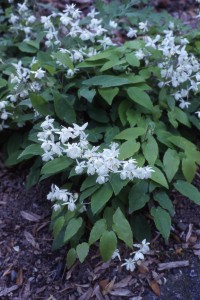
Epimedium x youngianum 'Niveum' in its April glory
While the robins celebrated spring by completing the last leg of their long journey, I was out in the garden performing one of the first jobs necessary to the season: uncovering my epimediums. (They have a common name—bishop’s hat—but somehow I just can’t bring myself to use it. They’ll always be epimediums to me.)
Along with hellebores and lungworts, epimediums start growing actively in March long before many of us have gotten out to remove the leaves that blew into the garden late last year after the rake had been put away for its long winter’s nap. (Or was it the gardener determined to nap? Tools can be convenient excuses…)
If you live on a lot with many trees, no matter how much you raked and blew last fall, you might find a lot of leaves staring up at you from the garden when the snow melts. Many plants can benefit from that cozy little coverlet, but for others it’s a problem.
While hellebores and lungworts are sturdy plants that can withstand the inevitable manhandling that occurs when you peel away sopping wet mats of oak leaves, epimediums are delicate little things with fragile stems all too easily snapped off. Wait even a week too long to clear them of leaf litter, and you may not be able to do it without surgical tools. (I exaggerate, but not by much.)
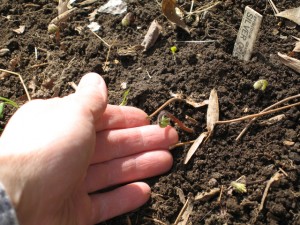
New epimedium growth under the leaf litter in March
At left is a picture of a curled epimedium flower stalk taken on March 20 just after being uncovered. This happens to be a patch of E. ‘Silver Queen’, a large-flowered white variety. In just a few weeks, it will put on a display to rival the extravagant bloomer E. x youngianum ‘Niveum’ shown in the picture above.
As careful as I tried to be when I removed the errant leaves, I wasn’t careful enough. Below left is a photograph of a stalk that I clumsily damaged. It takes almost no force to snap the top off these little guys, and that’s one spray of flowers less for me, the bees and everyone else this spring.
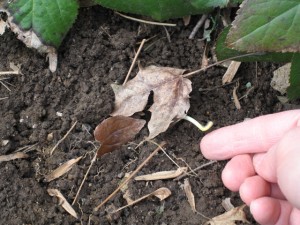
Epimedium stalk accidentally broken off
Some epimediums have fairly persistent stalks that don’t disintegrate on their own over winter. While you might not have to groom ‘Niveum’ at all, most others aren’t as accommodating. E. x perralchicum ‘Frohnleiten’ has perhaps the most evergreen leaves of any epimedium. This is both a plus and a minus. In snowless winters, they’re something to look at. But snow or no snow, in spring they’ll require cleanup. A pair of hedge clippers is the tool for this task. They do the job quickly and with all the precision required. You could just leave last year’s foliage alone, and new growth would come up through it and eventually conceal it, but most epimediums look better with a figurative shower and shave.
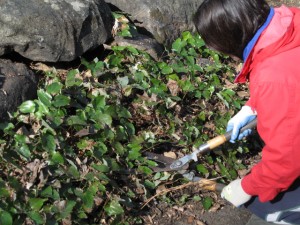
Shearing back epimediums in mid March
Unless you mulched last autumn, have some light, compost-based mulch handy to spread on your epimediums as soon as you uncover them. Otherwise, the soil around them will dry out quickly. At this time of year the sun is surprisingly intense, although most of us aren’t aware of it because air temperatures haven’t climbed yet. But I’ve learned that when I come out of my winter semi-hibernation and start working outdoors up to eight hours a day in March and April, I’d better wear sunscreen! New growth of shade-loving plants should also have some protection, not from the sun itself, but from the soil dryness it can cause.
Of course, even if I didn’t remove the leaves from my epimediums, they’d grow right up through their brown blanket and bloom anyway. But I prefer the look of a clean bed with a dressing of compost as a nice backdrop. Knowing that the job of removing those leaves without damaging the epimediums becomes harder with each passing day is enough incentive for me to get outside in mid March no matter what the weather. Ironically, as intolerant as they are of mishandling, fresh new epimedium growth will have no problem withstanding freezing nights.
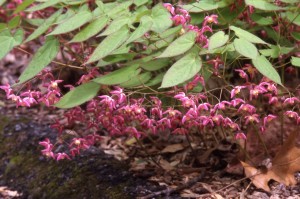
The reason for the work of the season. Darn—where'd that leaf come from?!
Spring!
Spring is just around the corner! Okay, not really, although according to the calendar the start of it is just two weeks away. For those of us in the North, the vernal equinox (that’s what will happen on March 20) is a purely conceptual start to spring. But the signs of the real thing are there, too, if you look. For one thing, the sugarhouses are steaming away, and “Pick up a gallon of medium amber” is on my To Do list. (Yes, I really go through a gallon of maple syrup each year. We’re having pancakes for dinner tonight.)
Outside, there are indicators that the change of seasons is under way. Just six days ago (Monday, March 2, 2009), we were blanketed by 15 inches of snow. Today, March 8, the only white stuff left is a few compacted inches in the shadow of trees and in the spots where the plows and snowblowers piled it up when the storm ended. For days, I’ve practically been able to see it melting.
This morning, with the thermometer reading a balmy 60°F (12°C), I went outside for the first of what will be many sessions picking up the detritus of winter (fallen tree branches, mainly) and pruning dead wood off various shrubs and trees. I took a moment to search for that most signal harbinger of spring: snowdrops (Galanthus spp.) As starkly obvious as little white and green flags against a sea of brown, they’re easy to pick out, even when they first emerge. What did I see? Nothing.
At 4:00 pm I went back outside to put my tools away, and my eyes were immediately drawn to several clumps of snowdrops pushing their way up into the light. Did they really shoulder aside the thick cover of last year’s fallen leaves in just a few hours? I wouldn’t be surprised. Spring is just around the corner.
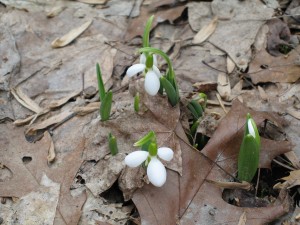
The first snowdrops of the year—March 8, 2009

